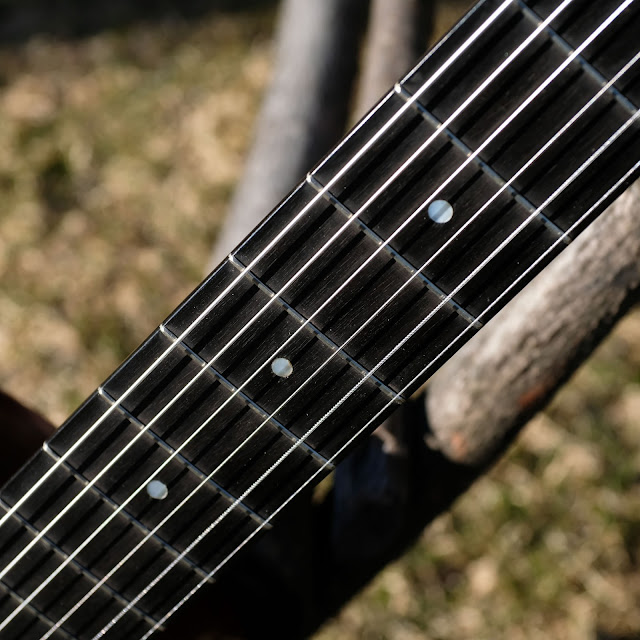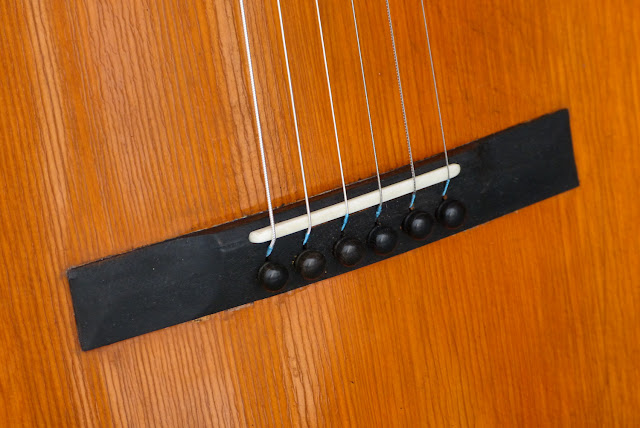1890s Howe-Orme Cylinder-Top Parlor Guitar
Update April 2018: I originally worked on this guitar in January 2017, but since then its original bridge exploded (not unexpected as these were ebonized poplar -- I believe -- and the ebonization agent destroys them structurally) and it received some split-endblock damage in shipping. I've replaced the broken original bridge with an antique rosewood one that I fit for this application and have also fixed the endblock damage. This post now has new pictures, a new video clip, and I've updated the description where necessary.
Howe-Orme cylinder-top instruments are exceedingly rare and the guitars (as opposed to the mandolins) are even rarer. They were marketed by the retailer Elias Howe out of Boston and this particular one bears a Bohmann repair label. I have a sneaking suspicion that the cylinder-top instruments themselves were made by Vega or Haynes/Bay State (both out of Boston), but that's absolutely unconfirmed. I do know that Howe did not make most of the instruments -- if any -- that they sold... and have seen a number of "Howe" banjos that were clearly made by other makers. Does anyone know a deeper version of the story that would confirm they were (or were not) made in their own factory?
Howe-Orme cylinder-top instruments are exceedingly rare and the guitars (as opposed to the mandolins) are even rarer. They were marketed by the retailer Elias Howe out of Boston and this particular one bears a Bohmann repair label. I have a sneaking suspicion that the cylinder-top instruments themselves were made by Vega or Haynes/Bay State (both out of Boston), but that's absolutely unconfirmed. I do know that Howe did not make most of the instruments -- if any -- that they sold... and have seen a number of "Howe" banjos that were clearly made by other makers. Does anyone know a deeper version of the story that would confirm they were (or were not) made in their own factory?
All that said -- this is an amazing instrument. The top is cut paper-thin, press-arched into its "cylinder" shape for strength and an overall featherweight build. The top is solid spruce and the back, sides, and neck are solid mahogany. The fretboard is excellent-quality ebony and the bridge is ebonized maple.
It has some thoroughly modern (and ingenious) features, including an adjustable neck-angle/orientation attachment that requires a cantilevered fretboard extension, radiused fretboard, and zero fret. These are all features that I love seeing on a guitar and are icing on the cake for an excellently-built instrument.
My work on it included regluing the bridge and cutting a new saddle slot, a fret level/dress, some minor seam and crack repairs, a replacement (antique) rosewood bridge install, endpin/endblock damage repair, and a good setup. I wrote a bit about the earlier repairs in two workshop posts. The owner decided to keep the compensation at the saddle "straight" so as to make it useful for gut/nylon strings which would've probably been on it when it was played "new." It's wearing a set of fancy Thomastik KR116 rope-core steel strings which have the same tension as nylon/classical strings and intonate the same way but have more of a steel-strung, fingerpicked tonality -- albeit with a bit more warmth and definition on the bass-end.
So what's my conclusion on the guitar? It's a "size 2" instrument but sounds much larger, has excellent projection for its size, and has a tone to die for. I simply love it. Unlike the later Vega cylinder-top guitars, it doesn't need much tension to drive the top, and the elevated fretboard extension and wide-nut, soft-v, slim front-to-back neck give it a professional feel. Action is spot-on at 3/32" at the 12th fret across the strings and quite adjustable to taste using the neck-adjuster gizmos.
The top is orange-stained like many guitars of the 1890s. The lower bout is 12 3/8" across which puts it in the "Martin size 2" realm, and the 25 1/8" scale is fairly long for the time (when 24" was more standard across makes).
Note the precision of the workmanship -- lines are crisp and cuts are clean. The nut width is 1 13/16" and the spacer-nut is ebony.
The Waverly tuners may put this more around 1900-1905, but my hunch is that this probably dates from the late 1890s.
The Waverly tuners may put this more around 1900-1905, but my hunch is that this probably dates from the late 1890s.
A radiused fretboard gives the neck a more modern feel.
The rosette looks great and the rolled-over edges of the top blend into the mahogany sides.
My replacement rosewood bridge is a 1910s-era antique and, I think, came off of an old Regal. It's Brazilian rosewood and has a celluloid saddle. It's slightly narrower the long way than the original bridge and slightly wider the short way. I added string-ramping behind the pins and I think I prefer the slightly-warmer sound of the celluloid saddle on this compared to the bone that used to be on the guitar. It thickens the tone in conjunction with the rosewood bridge itself.
As you can see, the saddle's shape is goosed to suit the radius of the fretboard. I know it's probably obvious, but I must say it was a little tricky to fit the replacement bridge to the top of this guitar. I was lucky-enough to start with a nice, thick, pyramid bridge before I started cutting it to fit.
Just for fun, here's a picture (above) of the "soft pyramid" bridge that was on it when it came in. It had several splits which I repaired back in 2017 along with a reglue job, but the old splits broke again and it failed on them. It's just the nature of the wood type.
The mahogany on the back and sides is uniform and simple, but the rich, red stain gives it a classy look. The backstrip is nice, too!
The back is flat, by the way.
The back is flat, by the way.
The neck actually isn't bolted to anything. If you remove the strings and pull back on it, it will fall away from the two locator/holder pins -- the one on the back of the heel, here, and one at the "front" of the heel that sits in the body. It's an interesting and effective design.
In this side view, you can see the way the heel "floats" beyond the body. The two wheel-looking devices at the top of the heel both adjust back-angle and side-to-side angle.
Here's a shot (above) of how the guitar originally left the workshop -- with a previously-repaired section of endblock... probably done by Bohmann out of Chicago.
Here's how that endblock area looks now. This was a complicated break that occurred right along the old damage line and separated the top from the block and made that ripple-crack to the side wood. It's all essentially flush and tidied-up and is structurally solid. It looks a little ugly but at least it's in the right place for ugliness -- somewhere you won't notice at a glance. The lighting in this shot also draws the eye to it -- which was the point.

Here's how that endblock area looks now. This was a complicated break that occurred right along the old damage line and separated the top from the block and made that ripple-crack to the side wood. It's all essentially flush and tidied-up and is structurally solid. It looks a little ugly but at least it's in the right place for ugliness -- somewhere you won't notice at a glance. The lighting in this shot also draws the eye to it -- which was the point.

Here's the shape of the top -- wild, isn't it? It's cut paper-thin, too.
There's a Joseph Bohmann repair label as well as the original Howe-Orme one!
Perhaps, some day, this stamp at the headstock will be more useful.






















Comments
How was the bracing pattern on it?
Sincerely,
Tyko Runesson, runessonguitars.com